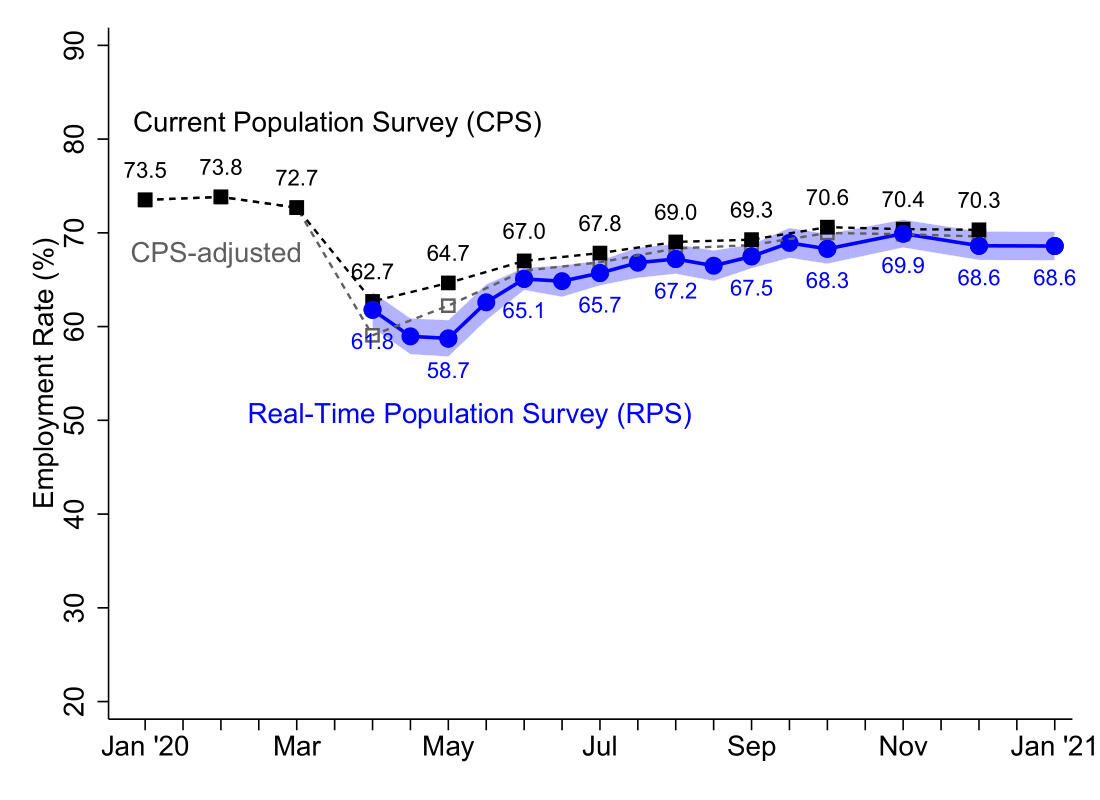
Jan. 26, 2021
U.S. employment has 'stopped recovering,' new survey shows
Share this story
The labor market recovery among working-age adults slowed the week of Jan. 10-16, shows a report by economists from Virginia Commonwealth University and Arizona State University.
Employment held constant from early December to early January at 68.6%, and remains 5.2 percentage points below the February 2020 level, according to the monthly Real-Time Population Survey conducted by Adam Blandin, Ph.D., an assistant professor in the VCU School of Business, and Alexander Bick, Ph.D., an associate professor of economics at Arizona State. In the spring of 2020, at the onset of COVID-19 in the United States, employment fell by 14% among working-age adults.
“This was a historic loss for the economy, both in its size and its speed,” Blandin said. “Fortunately, employment also rebounded quickly in the summer and fall. From April to October, employment increased by over 10%, meaning that the economy quickly recovered about two-thirds of lost jobs.
“However, since October, employment has stopped recovering, and has actually declined. We saw a continuation of this trend in January. This suggests that the early rapid recovery was only a partial one, and many workers who were working prior to the pandemic are still struggling to find work.”

The Real-Time Population Survey closely follows the methodology of the U.S. Bureau of Labor Statistics’ Current Population Survey and covers the same time period. However, Blandin and Bick release their results two weeks earlier. Additionally, they ask questions that the Current Population Survey does not, such as who is working for the same employer as pre-pandemic and who has lost or gained earnings since then.
Blandin and Bick started their survey out of a desire to use their skills as economists to help policymakers, reporters, analysts and the public during the COVID-19 pandemic. Their research has been cited widely in national publications such as The Wall Street Journal, Bloomberg, Business Insider, Forbes, The New York Times and The Washington Post, and has drawn attention from notable economists worldwide.
The latest survey results reflect the week of Jan. 10-16. Among the key findings:
- Among those who were working just before the pandemic, only about 60% are still working for the same employer. Of the remaining 40%, about 15% are not working, while about 25% are working for a new employer. This means that, in addition to the large effect on employment, the pandemic has had an incredibly large reallocation impact. It is not clear whether these new jobs will be long-lasting, or how well they pay compared to pre-pandemic work.
- At the same time, earnings have recovered for many individuals. About half of workers who were employed just prior to the pandemic are earning the same amount, and 1 in 5 workers are earning more than they did in February 2020, just before the pandemic. This still leaves over a quarter of workers earning less than just before the pandemic.
The Real-Time Population Survey is conducted in collaboration with the Federal Reserve Bank of Dallas. The results from this survey do not represent official forecasts or views of the Federal Reserve Bank of Dallas, its president, the Federal Reserve System or the Federal Open Market Committee.
Subscribe to receive future results at https://sites.google.com/view/
Subscribe to VCU News
Subscribe to VCU News at newsletter.vcu.edu and receive a selection of stories, videos, photos, news clips and event listings in your inbox.







